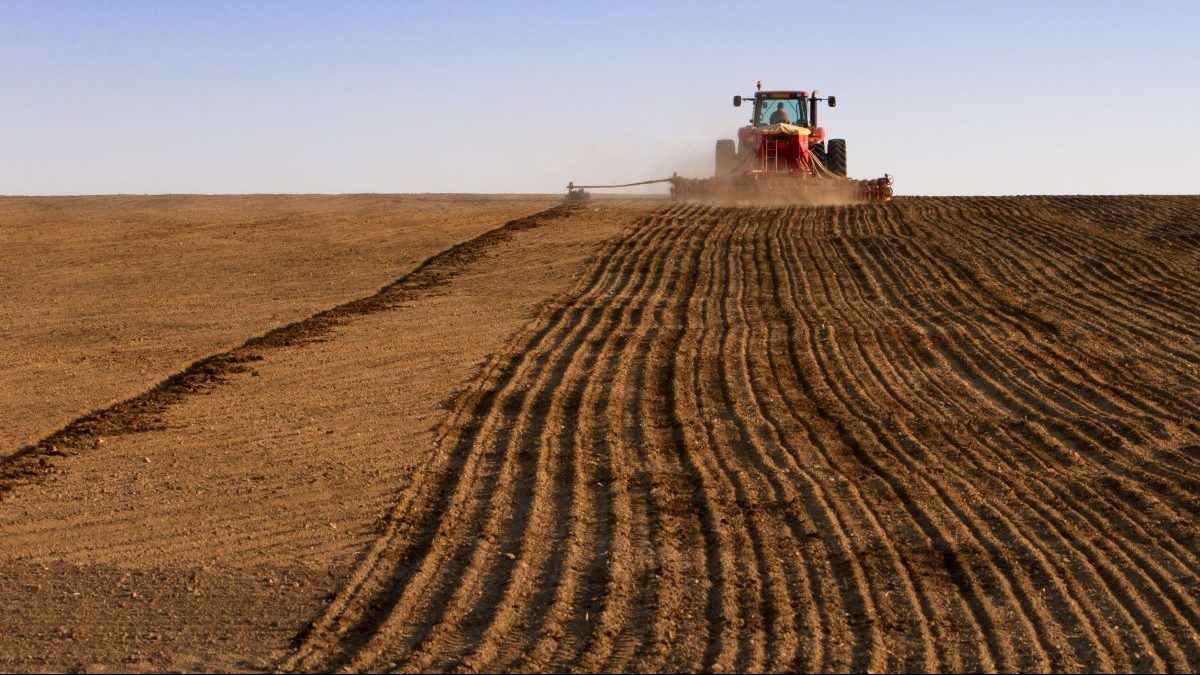
Planting of Australia’s winter crop is well advanced in all states including Western Australia. Photo: DPIRD
SFW WHEAT has passed the $500-per-tonne mark this week in eastern Australia, and is trading at close to $520/t in the Port Adelaide zone amid thin grower selling, buoyant demand from exporters with hatches to fill, and tight logistics.
The price exceeds the highs of around $465/t for ASW wheat delivered southern Queensland Downs in 2018, when drought had reduced local supplies, and ahead of interstate grain arriving in volume to settle the market at international parities.
India’s weekend announcement of its limit on wheat exports, coupled with production concerns in some key Northern Hemisphere growing regions, has been bullish for global grain values.
However, with much of Australia’s export surplus forward sold, it appears domestic issues, namely wet weather in places and a shortage of road transport everywhere, is also helping drive prices higher. See Beef Central’s report last week on lotfeeders’ cost of production challenges.
Bringing some hope of a levelling at least in global grain values is news that the United Nations is pushing to ensure exports of Ukrainian grain can resume to help allay growing concerns about global food security for human populations.
| Today | May 12 | |
| Barley Downs | $502 | $430 |
| SFW wheat Downs | $505 | $455 |
| Sorghum Downs | $382 | $370 |
| Barley Melbourne | $440 | $428 |
| ASW wheat Melbourne | $502 | $455 |
| SFW wheat Melbourne | $502 | $445 |
Table 1: Indicative delivered prices in Australian dollars per tonne.
Wet in parts of north
In the week to 9am today, some cropping regions in NSW had 5-45mm, with northern districts the wettest, and Mungindi on the Queensland border getting 67mm.
Significant rainfall has further delayed cotton picking and the harvest of late sorghum, as well as the planting of winter crops.
In Queensland, falls were generally less than 20mm on the central and eastern Darling Downs, but western regions and Central Queensland had some heavy falls, including: Emerald 47mm; Miles 58mm; Roma 50mm; Springsure 42mm.
The rain has again limited the amount of grain that can be out-turned from on-farm and bulk storages, and minor flooding continues to close a small number of roads.
It means stockfeed millers from Brisbane to the Inner Downs have had extreme difficulty getting deliveries, and some have had to switch at short notice from wheat and/or barley to sorghum as the only grain available in their orbit.
Beef lotfeeders have been particularly hard hit, as yesterday’s story details.
“Wheat on the Downs hit $500/t delivered for SFW, and barley is close to $500/t,” one trader said.
Wheat stocks in southern Queensland and northern NSW are ample for the domestic market, but getting them from storages to sites, and getting growers to engage in selling, remains the issue.
Much of the trade occurring at present is trade to trade, and is expected to stay that way until the new financial year starts on July 1.
“Growers are all cashed up, and they’re not interested in selling; we might see a bit more volume from them come on to the market once we get to July.”
The source said barley, which has very limited demand for export ex Brisbane, is in hot demand based on nutritionists’ advice, and appears set to become more expensive than wheat, as it did during the height of the 2017-19 drought.
Competition from Brisbane’s big bulk export program in wheat and sorghum continues, and trade sources said traders with export commitments to fill are offering the best road-transport rates to get vessels filled on time.
“If you had to pay demurrage on a vessel, or pay more for a road train, which one would you pick?”
Southern
The market for feed-type wheat remains hot in Port Adelaide, with SFW and ASW trading at around $515/t plus delivered consumer, and feed barley at around $450/t.
While most growers in eastern states and Western Australia are at least three-quarters of the way through their sowing programs, some South Australian growers are still waiting for a soaking rain to kick progress along.
“Lots of growers are still looking to the sky and wanting widespread rain, but most are 50pc or three quarters through,” Centre State Exports grower services manager Henry Voigt said.
He said Victorian growers have generally had a fantastic start, and SA ones still had some weeks in which to complete sowing.
“They’re not in panic stations yet.”
In Victoria, GeoCommodities broker Brad Knight said the delivered Melbourne SFW market hit $500/t on Tuesday, and some consumers were having to buy at current levels, particularly if they had been “fishing behind the net” during the rally of recent weeks.
Patchy and mostly light rain in Victoria and southern NSW, and scattered showers in South Australia, have done little to interrupt the movement of grain to south-eastern ports in the past week.
“We haven’t had the Mother Nature shocks to contend this week that the north has, but the market’s still very tight on freight.”
“Deliveries are tough.”
He said the logistics squeeze meant transport operators were looking for the most efficient sites to service, avoiding ones where tipping was slow, wait times were long, and access was difficult.
“There’s definitely some pushback on those poorer sites.”
Mr Knight said some growers were engaging in the market, but not at a level sufficient to get the liquidity required to help stabilise prices.
“The consumer continues to focus on what they have to buy, and is hoping for a bit of relief.”
Grain Central: Get our free news straight to your inbox – Click here
